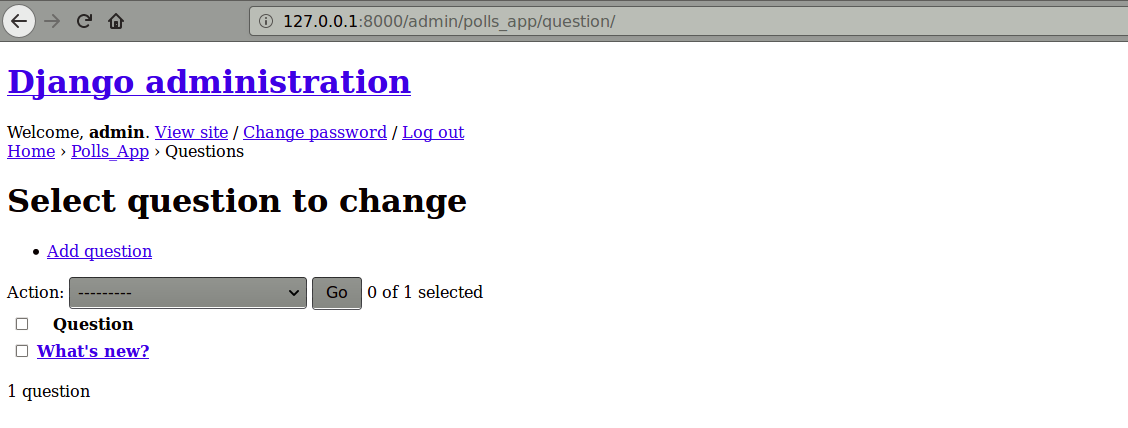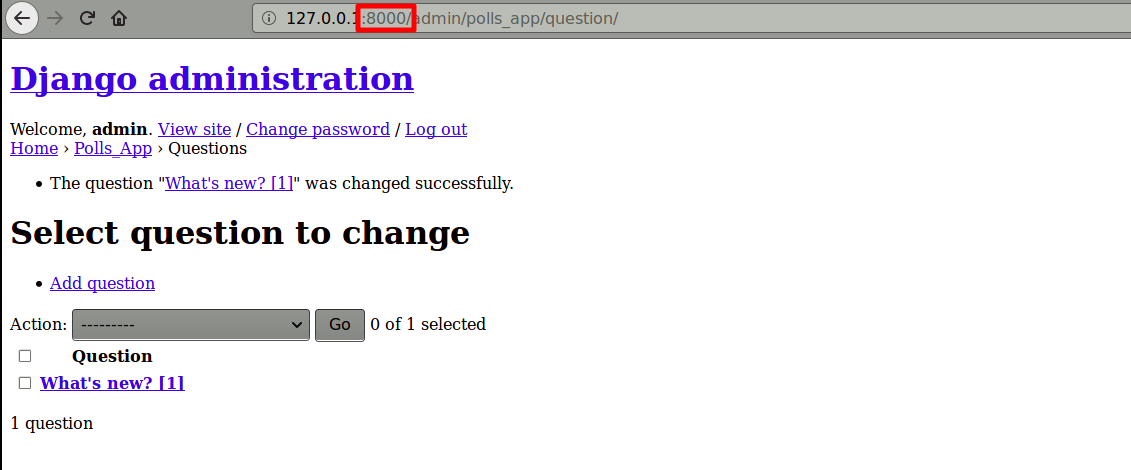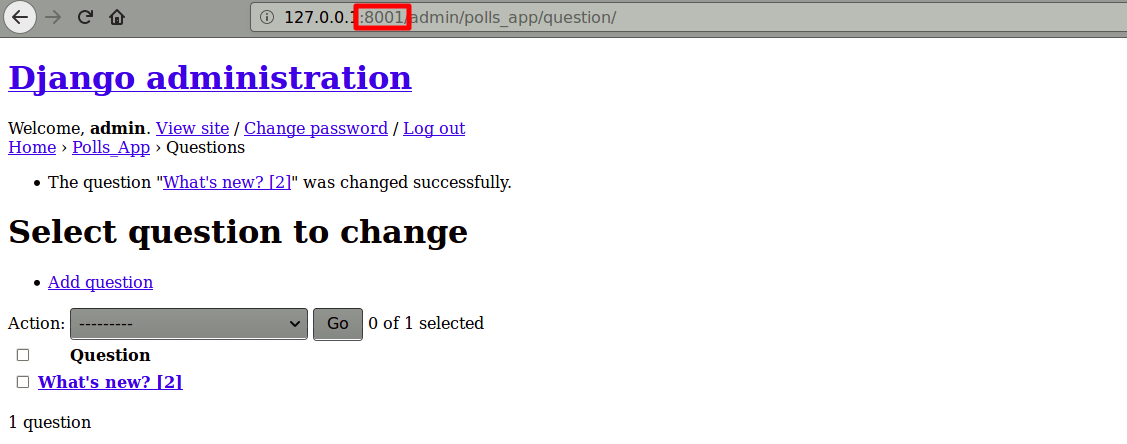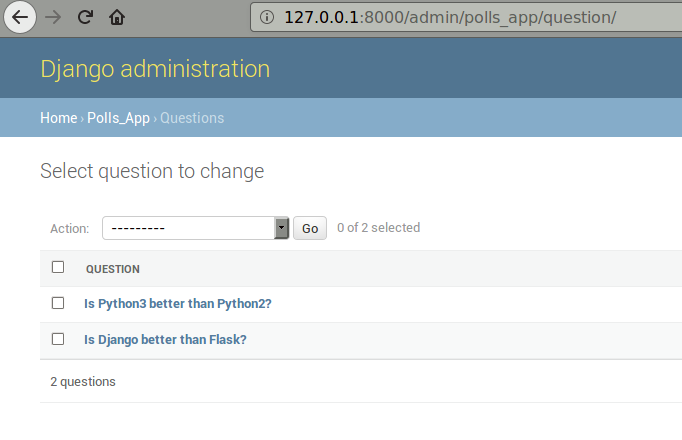This project follows on from my Writing_Django project, which is a simple Hello World in Django.
It will use gunicorn which is a web server for Django. Specifically, it is a WSGI server.
It will also use Docker and Kubernetes (initially via minikube).
It will be migrated to PostgreSQL for persistence via the Python Postgres module psycopg2.
The plan of attack is as follows:
- Install and test 'gunicorn'
- Dockerize our app
- Run our Dockerized app (1.0)
- Migrate our app to PostgreSQL
- Run our Dockerized app (2.0)
- Final teardown
- Software Versions
- Still To Do
Once all of this has been carried out locally, our app will be ready to be deployed in the cloud (AWS, Azure, GCP, etc.).
One of the convenient things about minikube is that it is local; this saves a lot of upload/download time. It's fast.
To install locally:
$ pip install --user gunicorn
As usual, replace pip with pip3 for Python3.
To verify the version:
$ pip list --format=freeze | grep gunicorn
Or simply use the requirements.txt file:
$ pip install --user -r requirements.txt
Lets see if it runs (this needs to be in the same folder as manage.py):
$ gunicorn polls.wsgi
[2018-02-13 17:30:31 +0000] [6232] [INFO] Starting gunicorn 19.7.1
[2018-02-13 17:30:31 +0000] [6232] [INFO] Listening at: http://127.0.0.1:8000 (6232)
[2018-02-13 17:30:31 +0000] [6232] [INFO] Using worker: sync
[2018-02-13 17:30:31 +0000] [6236] [INFO] Booting worker with pid: 6236
Not Found: /
Not Found: /favicon.ico
Not Found: /favicon.ico
^C[2018-02-13 17:31:06 +0000] [6232] [INFO] Handling signal: int
[2018-02-14 01:31:06 +0000] [6236] [INFO] Worker exiting (pid: 6236)
[2018-02-13 17:31:06 +0000] [6232] [INFO] Shutting down: Master
$
Now we need to open up gunicorn with a gunicorn.conf file. By default, gunicorn
runs locally and will only accept local connections. We will configure it to run in
promiscuous mode (which is a terrible practice, we should really run it behind a
front-end, but we can fix this later).
Once more, with a config file:
$ gunicorn -c ../gunicorn.conf polls.wsgi
[2018-02-18 15:24:35 +0000] [16256] [INFO] Starting gunicorn 19.7.1
[2018-02-18 15:24:35 +0000] [16256] [INFO] Listening at: http://0.0.0.0:8000 (16256)
[2018-02-18 15:24:35 +0000] [16256] [INFO] Using worker: sync
[2018-02-18 15:24:35 +0000] [16260] [INFO] Booting worker with pid: 16260
...
^C[2018-02-18 15:24:37 +0000] [16256] [INFO] Handling signal: int
[2018-02-18 23:24:37 +0000] [16299] [INFO] Worker exiting (pid: 16299)
...
[2018-02-18 23:24:37 +0000] [16285] [INFO] Worker exiting (pid: 16285)
[2018-02-18 15:24:37 +0000] [16256] [INFO] Shutting down: Master
$
Okay, everything runs.
Lets see if we can save some Docker build time:
$ sudo docker search python
....
$ sudo docker search django
....
$ sudo docker search gunicorn
....
Hmm, maybe it would be faster to do a search from:
https://hub.docker.com/explore/
Or maybe not, it looks like the official Django image is deprecated:
https://hub.docker.com/_/django/
[This page has a link to the Docker Store version of Django: 404]
Okay, the recommendation is to start with a Python image, lets do that.
The options are endless:
https://hub.docker.com/_/python/
[Of course, it doesn't really make any sense to Dockerize an app with a bundled database - but we will address that later.]
We need to change our Django settings to allow '192.168.99.100' (minikube traffic)
in addition to '127.0.0.1' (local traffic). Change the line ALLOWED_HOSTS = [] in
polls/settings.py as follows:
ALLOWED_HOSTS = ['127.0.0.1', '192.168.99.100']
[We should revisit these settings once everything runs behind a front-end.]
Lets build our dockerized app:
$ sudo docker build -f Dockerfile_1.0 -t mramshaw4docs/python-django-gunicorn:1.0 .
Available from DockerHub here.
Okay, lets check the software versions bundled in our Dockerized app:
$ docker run --rm -it mramshaw4docs/python-django-gunicorn /bin/sh
/usr/src/app # python --version
Python 3.6.4
/usr/src/app # python -m django --version
1.11.10
/usr/src/app # gunicorn --version
gunicorn (version 19.7.1)
/usr/src/app # exit
$
Apart from the Python version, the same software as in the original Writing_Django project.
Lets quickly run and - more importantly - test our Dockerized app.
Start minikube:
$ minikube start
Starting local Kubernetes v1.9.0 cluster...
Starting VM...
Getting VM IP address...
Moving files into cluster...
Setting up certs...
Connecting to cluster...
Setting up kubeconfig...
Starting cluster components...
Kubectl is now configured to use the cluster.
Loading cached images from config file.
$
Run our dockerized app:
$ kubectl create -f ./polls.yaml
Lets check our deployment first. Port-forward our pod (as usual, Ctrl-C to terminate):
$ kubectl port-forward polls-7bd58769c7-r27rr 8000:8000
Forwarding from 127.0.0.1:8000 -> 8000
Handling connection for 8000
....
This will make our app available at 127.0.0.1:8000 where we will test it:
Okay, so now we know the deployment portion of our yaml is good. We can kill our port-forwarding now (Ctrl-C to terminate):
Handling connection for 8000
^C$
Lets increase the number of replicas to 2. Edit polls.yaml, save it, and apply it:
$ kubectl apply -f ./polls.yaml
Warning: kubectl apply should be used on resource created by either kubectl create --save-config or kubectl apply
deployment "polls" configured
Warning: kubectl apply should be used on resource created by either kubectl create --save-config or kubectl apply
service "polls" configured
$
The warnings are because these resources were created with kubectl create. If we change the replicas back to 1 and run kubectl apply again:
$ kubectl apply -f ./polls.yaml
deployment "polls" configured
service "polls" unchanged
$
So lets increase the number of replicas to 2 again:
$ kubectl apply -f ./polls.yaml
deployment "polls" configured
service "polls" unchanged
$
[Note no warning this time; the last kubectl was an apply.]
Now we will port-forward each of our Kubernetes pods and change each poll question so each pod has a different question:
$ kubectl port-forward polls-7cd964c89-4px25 8000:8000 &
[1] 5899
$ Forwarding from 127.0.0.1:8000 -> 8000
kubectl port-forward polls-7cd964c89-wqkxc 8001:8000 &
[2] 5912
$
Pod 1
Pod 2
Now we can try to access our Kubernetes pods through a Kubernetes service (this will pop open a browser):
$ minikube service polls
We can access our service now (note that this is a NodePort service), but things are pretty hit-and-miss. Most of the time we cannot even log in, and when we can which pod we get is kind of a crap-shoot (that's why we made sure each pod had different questions, so we could see which one we were accessing).
Lets see if 'sticky sessions' help at all:
$ kubectl apply -f ./polls-svc-sticky.yaml
service "polls" configured
$
Yes, that definitely does seem to improve things - no more inconsistent
behaviour (eventually we will rely on our front-end for session management,
this was simply a little experiment). Now that we know that the service part
of polls.yaml works, we simply need to make our app reference a non-bundled
back-end.
[Although it works, it looks pretty horrible as our static content is missing.
We can fix that later, probably with a front-end or an ingress controller.]
Lets teardown our local Kubernetes infrastructure:
$ kubectl delete svc/polls deploy/polls
Finally:
$ minikube stop
Stopping local Kubernetes cluster...
Machine stopped.
$
Postgres is a mature database that offers replication, which is important for scaling in the cloud. It has had streaming replication since PostgreSQL 9 and - with PostgreSQL 10 - offers logical replication.
[Streaming replication is physical replication, where the replicas are binary copies. Replication is at the block level with changes of these blindly propagated to the replicas. With logical replication, record level changes are propagated. And these can be on a table by table, or even record by record, basis. Think sharding.]
We will repeat most of the steps listed here:
https://docs.djangoproject.com/en/1.11/intro/tutorial02/
However, we will be using postgres instead of sqlite.
We will need the Python Postgres module psycopg2:
$ pip install --user psycopg2
[As usual, replace with pip3 for Python3.]
Verify the latest version:
$ pip list --format=freeze | grep psycopg2
psycopg2 (2.7.4)
$
[2.7.4]
We will use the official Docker image for postgres:
https://hub.docker.com/_/postgres/
Run it:
$ docker run --rm -it --name polls-postgres -d postgres:10.2-alpine
And a quick smoke test:
$ docker run -it --rm --link polls-postgres:postgres postgres:10.2-alpine psql -h postgres -U postgres
psql (10.2)
Type "help" for help.
postgres=# \conninfo
You are connected to database "postgres" as user "postgres" on host "postgres" at port "5432".
postgres=# SELECT 1;
?column?
----------
1
(1 row)
postgres=#
And now the important part - creating our database:
postgres=# CREATE DATABASE polls;
CREATE DATABASE
postgres=# \q
$
Okay, we have a functional postgres. Lets tear it down:
$ docker kill polls-postgres
We will go through most of this again in Create postgres backend shortly.
Change polls/settings.py as follows. First insert:
DATABASES = {
'default': {
'ENGINE': 'django.db.backends.postgresql_psycopg2',
'NAME': 'polls',
'USER': 'postgres',
'PASSWORD': 'postgres',
'HOST': '127.0.0.1',
'PORT': 5432
}
}
Then remove or comment:
DATABASES = {
'default': {
'ENGINE': 'django.db.backends.sqlite3',
'NAME': os.path.join(BASE_DIR, 'db.sqlite3'),
}
}
[This uses default passwords which is generally a very lazy and insecure practice. It's actually even worse as we are using the root postgres user and password. The default root user and password. We will need to harden all of this before we get too much further, but especially before any move into production.]
Start minikube:
$ minikube start
....
Start postgres:
$ kubectl create -f ./postgres.yaml
Shell into our backend pod and create our polls database:
$ kubectl exec -it polls-backend-67c86654df-xll2q sh
/ # psql -U postgres
psql (10.2)
Type "help" for help.
postgres=# \conninfo
You are connected to database "postgres" as user "postgres" via socket in "/var/run/postgresql" at port "5432".
postgres=#
[This would be the point at which to harden everything with the \password postgres command and so forth,
but for testing purposes we will not do this.]
postgres=# CREATE DATABASE polls;
CREATE DATABASE
postgres=# \q
/ # exit
$
Much like PHP's Laravel framework, Django will handle SQL generation and migration for any defined data structures.
Port-forward our postgres pod (as usual, Ctrl-C to terminate):
$ kubectl port-forward polls-backend-67c86654df-xll2q 5432:5432
In a new window, run our Django server (needs to be in the folder where manage.py resides):
$ cd polls
$ ls -al
total 64
drwxrwxr-x 4 owner owner 4096 Feb 15 22:46 .
drwxrwxr-x 5 owner owner 4096 Feb 16 08:27 ..
-rw-r--r-- 1 owner owner 41984 Feb 12 10:24 db.sqlite3
-rwxrwxr-x 1 owner owner 803 Feb 11 13:40 manage.py
drwxrwxr-x 2 owner owner 4096 Feb 15 19:31 polls
drwxrwxr-x 3 owner owner 4096 Feb 15 11:58 polls_app
$ python manage.py runserver
Performing system checks...
System check identified no issues (0 silenced).
You have 14 unapplied migration(s). Your project may not work properly until you apply the migrations for app(s): admin, auth, contenttypes, polls_app, sessions.
Run 'python manage.py migrate' to apply them.
February 15, 2018 - 22:09:42
Django version 1.11.10, using settings 'polls.settings'
Starting development server at http://127.0.0.1:8000/
Quit the server with CONTROL-C.
Not Found: /
[15/Feb/2018 22:12:35] "GET / HTTP/1.1" 404 2017
^C$
Before killing it, check that it runs:
Lets check our database migrations:
$ python manage.py showmigrations
admin
[ ] 0001_initial
[ ] 0002_logentry_remove_auto_add
auth
[ ] 0001_initial
[ ] 0002_alter_permission_name_max_length
[ ] 0003_alter_user_email_max_length
[ ] 0004_alter_user_username_opts
[ ] 0005_alter_user_last_login_null
[ ] 0006_require_contenttypes_0002
[ ] 0007_alter_validators_add_error_messages
[ ] 0008_alter_user_username_max_length
contenttypes
[ ] 0001_initial
[ ] 0002_remove_content_type_name
polls_app
[ ] 0001_initial
sessions
[ ] 0001_initial
$
And run them:
$ python manage.py migrate
Operations to perform:
Apply all migrations: admin, auth, contenttypes, polls_app, sessions
Running migrations:
Applying contenttypes.0001_initial... OK
Applying auth.0001_initial... OK
Applying admin.0001_initial... OK
Applying admin.0002_logentry_remove_auto_add... OK
Applying contenttypes.0002_remove_content_type_name... OK
Applying auth.0002_alter_permission_name_max_length... OK
Applying auth.0003_alter_user_email_max_length... OK
Applying auth.0004_alter_user_username_opts... OK
Applying auth.0005_alter_user_last_login_null... OK
Applying auth.0006_require_contenttypes_0002... OK
Applying auth.0007_alter_validators_add_error_messages... OK
Applying auth.0008_alter_user_username_max_length... OK
Applying polls_app.0001_initial... OK
Applying sessions.0001_initial... OK
$
So now we can create our app migration(s):
$ python manage.py makemigrations polls_app
No changes detected in app 'polls_app'
$
Interestingly, this is not what I was expecting. Lets double-check:
$ mv polls_app/migrations/0001_initial.py polls_app/migrations/0001_initial.py.orig
$ python manage.py makemigrations polls_app
Migrations for 'polls_app':
polls_app/migrations/0001_initial.py
- Create model Choice
- Create model Question
- Add field question to choice
$ diff -uw polls_app/migrations/0001_initial.py.orig polls_app/migrations/0001_initial.py
--- polls_app/migrations/0001_initial.py.orig 2018-02-11 15:32:37.401180000 -0800
+++ polls_app/migrations/0001_initial.py 2018-02-15 14:28:24.501089257 -0800
@@ -1,5 +1,5 @@
# -*- coding: utf-8 -*-
-# Generated by Django 1.11.10 on 2018-02-11 23:32
+# Generated by Django 1.11.10 on 2018-02-15 22:28
from __future__ import unicode_literals
from django.db import migrations, models
$
Okay, looks like everything is copacetic:
$ rm polls_app/migrations/0001_initial.py.orig
Lets see if the generated SQL is any different from the sqlite SQL:
$ python manage.py sqlmigrate polls_app 0001
BEGIN;
--
-- Create model Choice
--
CREATE TABLE "polls_app_choice" ("id" serial NOT NULL PRIMARY KEY, "choice_text" varchar(200) NOT NULL, "votes" integer NOT NULL);
--
-- Create model Question
--
CREATE TABLE "polls_app_question" ("id" serial NOT NULL PRIMARY KEY, "question_text" varchar(200) NOT NULL, "pub_date" timestamp with time zone NOT NULL);
--
-- Add field question to choice
--
ALTER TABLE "polls_app_choice" ADD COLUMN "question_id" integer NOT NULL;
CREATE INDEX "polls_app_choice_question_id_38df74ee" ON "polls_app_choice" ("question_id");
ALTER TABLE "polls_app_choice" ADD CONSTRAINT "polls_app_choice_question_id_38df74ee_fk_polls_app_question_id" FOREIGN KEY ("question_id") REFERENCES "polls_app_question" ("id") DEFERRABLE INITIALLY DEFERRED;
COMMIT;
$
[Yep, some very slight differences, minor SQL dialect issues.]
Check for any issues:
$ python manage.py check
System check identified no issues (0 silenced).
$
And migrate again to apply our migrations:
$ python manage.py migrate
Operations to perform:
Apply all migrations: admin, auth, contenttypes, polls_app, sessions
Running migrations:
No migrations to apply.
$
[Not quite what I expected, but makes sense as there haven't been any changes. If we check showmigrations we will see everything is fine.]
Now we will create some (different) poll questions:
$ python manage.py shell
Python 2.7.12 (default, Dec 4 2017, 14:50:18)
Type "copyright", "credits" or "license" for more information.
IPython 2.4.1 -- An enhanced Interactive Python.
? -> Introduction and overview of IPython's features.
%quickref -> Quick reference.
help -> Python's own help system.
object? -> Details about 'object', use 'object??' for extra details.
In [1]: from polls_app.models import Question, Choice
In [2]: Question.objects.all()
Out[2]: <QuerySet []>
In [3]: from django.utils import timezone
In [4]: q = Question(question_text="Is Django better than Flask?", pub_date=timezone.now())
In [5]: q.save()
In [6]: q = Question(question_text="Is Python3 better than Python2?", pub_date=timezone.now())
In [7]: q.save()
In [8]: Question.objects.all()
Out[8]: <QuerySet [<Question: Is Django better than Flask?>, <Question: Is Python3 better than Python2?>]>
In [9]: quit
$
Create an Admin user ('admin' and '123abcde' again):
$ python manage.py createsuperuser
Username (leave blank to use 'owner'): admin
Email address: admin@example.com
Password:
Password (again):
Superuser created successfully.
$
Run our (local) server:
$ python manage.py runserver
....
Log in:
Okay, we have a configured postgres backend. Now we can replicate our Django pods.
We can kill our local server, as well as our postgres port-forwarding (but not our postgres pod!).
Lets build our dockerized app again - this will be the 2.0 version with postgres support:
$ sudo docker build -f Dockerfile_2.0 -t mramshaw4docs/python-django-gunicorn:2.0 .
Available from DockerHub here.
And check versions:
$ docker run --rm -it mramshaw4docs/python-django-gunicorn:2.0 /bin/sh
/usr/src/app # python --version
Python 2.7.13
/usr/src/app # python -m django --version
1.11.10
/usr/src/app # gunicorn --version
gunicorn (version 19.7.1)
/usr/src/app # pip list --format=freeze | grep psycopg2-binary
/usr/src/app # pip list --format=freeze | grep psycopg2
psycopg2 (2.7.4)
/usr/src/app # exit
$
[Hmm, that should really have been Python 3, can fix later.]
Lets change polls.yaml for our mramshaw4docs/python-django-gunicorn:2.0 version and 3 replicas. Also, add:
sessionAffinity: ClientIP
sessionAffinityConfig:
clientIP:
timeoutSeconds: 10800
Then save it as 'polls-postgres.yaml' and run:
$ kubectl create -f ./polls-postgres.yaml
Finally, lets try out our latest polls service:
$ minikube service polls
[This will pop open a browser.]
To simply see the service address:
$ minikube service --url polls
http://192.168.99.100:30919
$
[This can be opened in a browser.]
And finally, close everything down:
$ kubectl delete -f ./polls-postgres.yaml
service "polls" deleted
deployment "polls" deleted
$ kubectl delete -f ./postgres.yaml
service "polls-backend" deleted
deployment "polls-backend" deleted
$ minikube stop
Stopping local Kubernetes cluster...
Machine stopped.
$
- Django 1.11.10
- Docker 17.12.0-ce (Client and Server)
- gunicorn 19.7.1
- kubectl (Client: v1.8.6, Server: v1.9.0)
- Kubernetes v1.9.0
- minikube v0.25.0
- psycopg2 2.7.4
- Python - various
- PostgreSQL 10.2
- Add a Snyk.io vulnerability scan badge
- Upgrade to most recent minikube (v0.25.0)
- Upgrade to most recent kubectl (v1.8.6 - client, v1.9.0 - server)
- Verify
pollsapp (written and tested with Python 2.7.12) works with the latest Python (3.6.4) - Experiment with
sticky sessions - Experiment with various
servicetypes [minikube does not support LoadBalancer services] - Update
pipinstructions for latestpip(format: freeze replaces legacy) - Add Kubernetes health checks
- Handle Django static content (CSS, etc.)
- Harden Django/gunicorn configuration
- Harden everything else with non-default passwords and credentials
- Persist the back-end database
- Replicate the back-end database (probably logically using WAL)
- Investigate adding a cache (probably
redisrather thanmemcached/pgmemcache) - Upgrade the 2.0 Django server to a 3.0 Django server (Python3)




